|
FAQs about Hermit, Anomuran Crab Identification 4
Related Articles:
Hermit Crabs,
Crabs,
Marine Scavengers,
Fresh to Brackish Crabs,
Related FAQs:
Hermit ID 1,
Hermit IDs 2, Hermit IDs 3, & Hermit Crabs
1, Hermit Crabs 2,
Hermit Crabs 3, Hermit Behavior, Hermit Compatibility, Hermit Selection, Hermit Systems, Hermit Feeding, Hermit Reproduction, Hermit Disease/Health,
FAQs: By species:
Calcinus laevimanus (Zebra, Left-handed Hermit)
Clibanarius tricolor
(Blue-Legs),
Clibanarius vittatus (a common Gulf of Mexico hermit crab),
Dardanus megistos Shell-Breaking Reef, White-spot, Fuzzy Leg Hermit Crab),
Paguristes cadenati (Scarlet, Red-Legged),
Petrochirus diogenes (and other Giant Hermit Crabs), &
Anemone Hermits,
Sponge/Staghorn/Coral house Hermits,
Unknown/Wild-collected,&
Land Hermit Crabs,
Squat Lobsters, Micro-Crustaceans, Amphipods, Copepods, Mysids, Hermit
Crabs, Shrimps,
Cleaner
Shrimps, Banded Coral
Shrimp, Mantis
Shrimp, Anemone
Eating Shrimp, Marine Scavengers,
Crustacean Identification, Crustacean Selection, Crustacean Behavior, Crustacean Compatibility, Crustacean Systems, Crustacean Feeding, Crustacean Disease,
Crustacean Reproduction
|
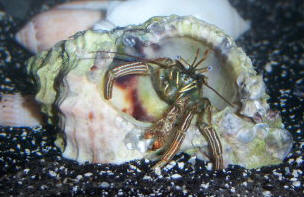
|
|
Hermit ID 12/24/13
Hey, I was wondering if you could help me out with the ID of this hermit
crab (not my picture). I think it might be a Dardanus?
<Nope>
A shove into the right direction like the correct genus would be nice if
possible at least.
Thanks,
Daniel Martin
<Nice pic...
http://www.wetwebmedia.com/marine/inverts/arthropoda/crabs/hermitcrabs.htm
Bob Fenner>
|
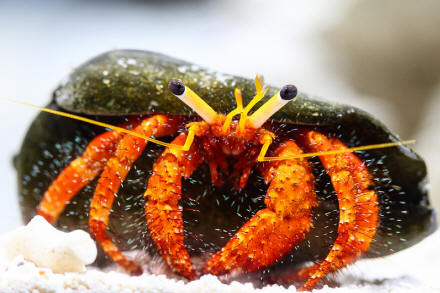
|
Re: Hermit ID 12/25/13
Hmm, he doesn't seem to match any of the species listed on that page.
<Oh come on now; with those gorgeous yellow eye stalks? Look up the
genus Paguristes. BobF>
Re: Hermit ID 12/25/13
Gahhhh that's a much larger genus to delve into... Meanwhile, I combed
through the Dardanus genus... Not many color pictures out there for most
of the species. And info in general is lacking. But I did find a picture
that is very similar: Dardanus australis (attached). You think this
might be the species?
<What the?! Do you know where your Hermit was collected? I had made it
out to be P. cadenati. B>
|
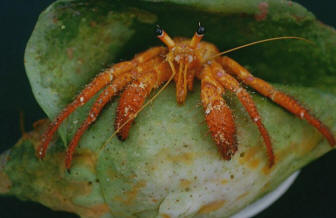 |
Re: Hermit ID 12/26/13
Nah, take a closer look. This guy is hairy as HECK. P. cadenati is
as smooth as a baby's bottom. It can't possibly be P. cadenati, right?
<... possibly. A common species...>
|
What kind is he and how should I care for him ASAP??? Hermit ID... 9/28/13
My fiancé and I were walking the beach in Orange Beach, Alabama. There
are huge rocks that sort of block the way for the boats to travel out.
These rocks are HUGE and we were brave enough to walk to the other side
of them.
There were tiny barnacles everywhere along with about 10-15 beautiful
shells. My fiancé grabbed one up and realized it was a hermit crab.
Thinking it was a normal hermit,
<Which are fully aquatic.>
I kept him and was so happy to have been able to find our own. The only
thing I am concerned about is the fact that he was UNDER the water when
we found him along with all the others.
<Indeed. Relatively few are amphibious, and only a handful terrestrial.
That said, because you collected this specimen in the surf zone, where
water is a few inches deep much of the time, you could have either an
aquatic one or an amphibious one.>
Completely submerged. It's been 2 days and he's still alive and starting
to not be as shy. I have him in a 10 gallon tank but I don't know if
that's what I should be doing considering the fact that he was
underwater. He doesn't have the big fat pinchers like the ones I've had
before either.
They are smaller and more narrow and red around the outside black on the
inside.
<Sounds like a Clibanarius species; relatively common along the
subtropical Atlantic coastline of the US. Look for Clibanarius vittatus
online to get an idea of what one common species in the genus looks
like. Clibanarius tricolor is another common species, though more
associated with the Caribbean.
http://www.wetwebmedia.com/marine/inverts/arthropoda/crabs/hermitcrabs.htm
Both are fully aquatic and much kept in aquaria.>
Any information as soon as possible would be so very appreciated. I do
love my animals and if this habitat is not proper I would really love to
know.
Thank you much, Victoria
<A local marine biologist will probably be better at identifying the
precise species you have. If in doubt, lower the waterline a bit, pile
some rocks up, and see if the Hermit crawls out at all. If it does, then
there's your answer! Hope this helps. Cheers, Neale.>
|
Hermit identification. 5/17/13
Hi its me again i forgot to attach photos in the first email.
<... 11.6 megs? See our file size limit requirement. Your files have
been auto-deleted>
I ordered some crabs online and got some hitchhikers instead of part of
my order. They don't seem to cause trouble needles to say I'm wondering
if one of them was the cause of some scarlet and white leg crabs
arriving dead.
Are this guys ok for a reef tank? Is there a general characteristic to
look for in hermits that will tell you if they are reef safe or
not?
<None are absolutely. Posted on WWM>
That's the four that I got as hitchhikers. Not sure if they are safe for
a reef tank.
Also I got about 30 small blue legs I added to my tank, about 1/2" in
size.
How many shells and what size do I need to get to keep my snail safe?
thanks for all the help.
<... an assortment of sizes... more than the number of hermits. Bob
Fenner>
Re: Hermit identification. 5/17/13
<.... see WWM... not megs. Get a computer perhaps>
It must have been a glitch in the phone it told me that the size was 3
Meg's or so when I was sending it. Here are the pics again.
I read the article on the WWM, but I figured that you can give me a
definite answer. I know mostly I'm worried that it might grow up big an
mess with other inhabitants. And catching a hermit crab in a tank that
has 100lb of live rock is a pain. That's why I want to have an experts
opinion on what these are. I would hate to have to flush the poor
bastards i could not figure out if they are safe and I got no one I can
give them to.
Re: Hermit identification. 5/17/13
I assumed that it was per picture as in several pictures can be bigger
than that. Here is the severely downsized version but I'm not sure if it
would be a good enough quality.
<Uhh, read here:
http://www.wetwebmedia.com/hermitidf4.htm
Search before writing us. B>
|
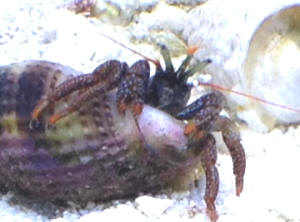 see below
see below |
|
Hermit Crab and Nudibranch: Clibanarius cruentatus and
Aeolidiella alba, IDs, comp. – 11/13/12
> Hi,
> <Hello, Lynn here this morning.>
> I recently brought 2 'Mexican algae hermit crabs' that were supposed
to be reef safe, one of them I cannot identify the species... Any idea?
> <Yep, it appears to be Clibanarius cruentatus, aka the “Spotted Black
Hermit crab”, which is in the family Diogenidae (left-handed hermits).
Whether this species is completely “reef-safe” depends on your
definition of the term. Hermits are typically omnivorous but can have
tendencies toward being either more herbivorous or carnivorous.
What's important is that if/when their preferred food dwindles, and they
get hungry enough, they will likely “sample” whatever else is available.
Bottom line: keep an eye on any and all hermits - even those labeled as
reef-safe, algae-eaters, or herbivores. That is, watch what they
tend to eat, make sure they have enough, and monitor for any damage to
livestock. It’s a good idea to supplement their food with meaty
bits of marine origin, sinking pellets, and/or bits of Nori (dried
seaweed sheets). Please see the following link for more
information and photos regarding Clibanarius cruentatus:
http://www.wildsingapore.com/wildfacts/crustacea/othercrust/anomura/hermit/spottedblack.htm
> More information on hermits here:
http://www.wetwebmedia.com/marine/inverts/arthropoda/crabs/hermitcrabs.htm?h=
>
> Also found a Nudibranch on my live rock which I cannot identify.
He doesn't seem to have touched my corals.
> <That’s good to “hear”/read but do keep an eye on them as sometimes
the damage isn't immediately apparent. You have what appears to be a
species known as Aeolidiella alba (family Aeolidiidae). If you can get a
close look at the base of the rhinophores (the knobby-looking appendages
just behind the head), you should see either a fine reddish line, ring,
or splotch (see photos at links below for comparison). Also reported, is
this species’ odd appearance during locomotion as it “waves” or “jerks”
its cerata (appendages along the back) back and forth.
Unfortunately, I wasn’t able to locate any information regarding the
animal’s diet, but rest assured, it’s a carnivorous predator. These
Nudibranchs tend to hitchhike on or near their food source so if your
individual arrived on a recent coral addition, I’d remove it asap, and
keep an eye out for others.
> Please see the following links for photos and more information:
http://www.seaslugforum.net/showall/aeolalba
>
http://seaslugsofhawaii.com/species/Aeolidiella-alba-a.html
> More information on Aeolids here:
http://www.wetwebmedia.com/MolluscPIX/Gastropods/Opistobranchs%20Sea%20Slugs/Nudibranchs/nudibran5.htm?h=
> Take care,
> -Lynn Z>
|
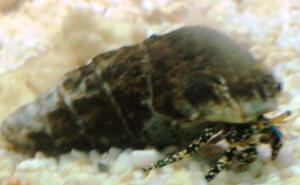
%20Nudi%20ID.jpeg) |
|
Re: Hermit Crab and Nudibranch: Clibanarius cruentatus and
Aeolidiella alba – 11/13/12
Thanks,
<You’re very welcome.>
..he came with my live rock which had 1 single Zoa and a single mushroom as
hitchhikers. I let the rock cycle and he is still alive and the Zoa and
mushroom are fine so I don't know what he could have been eating to live.
<Based on what seems to be the common theme within this family, I’d say a
Cnidarian of some sort. Every Aeolidiella species that I was able to find
diet-related information regarding, listed one/several varieties of anemone
as being their prey of choice. Interestingly enough, other genera within the
family (Aeolidiidae) listed hydroids and Palythoa in addition to anemones so
that adds to the list of possibilities. Whatever the prey, it’s possible
that there may still be some small/hidden individuals left that are
sustaining your Nudi. On the flipside, if it has already gone through the
food supply, you will likely see the animal roaming about the tank for a
short while, then one day it’ll just disappear. Take care, Lynn Z>
Re: Ahh, excellent as always. B – 11/13/12
Thanks Bob, it was a pleasant surprise to see that query in the inbox this
morning. I check in every day, looking for ID's but must be missing
them.
At any rate, it's always a pleasure to see what neat little critters end up
in people's systems!
Take care and thanks again,
-Lynn
|
|
Hermit Crab ID – 6/21/12
Hello,
<Hello Laura, Lynn here today.>
I have searched several sites, and at several LFS's for an ID on this
Hermit Crab. I have gotten conflicting results that upon further
research don't seem to fit this guy. It is currently residing in
an approx. 3/4" turbo snail shell that it "removed" the snail from.
<Was the snail already dead or did the hermit kill it? Either way,
be sure to offer a few (empty) shells for the hermit to use as it
outgrows the smaller ones.>
It is brownish in color, left-clawed,
<Good, we can start looking into the family Diogenidae for potential
candidates.>
…orange antennae, blue eyes, and has a bright orange stripe centered on
the front of its legs. It does not appear to be overly hairy.
Please see attached photo.
<Thanks, do you know where the hermit came from/originated? The
closest I can find at the moment are two species in the genus Calcinus,
but both have black eyes instead of blue. Please see the following
links for comparison but bear in mind that color can vary to a
surprising degree within each species: C. californiensis:
http://biomar.free.fr/calcinus/images/calcinus_californiensis.jpg
C. tibicen:
http://reefguide.org/carib/orangeclawhermit.html
More information regarding hermits in general:
http://www.wetwebmedia.com/marine/inverts/arthropoda/crabs/hermitcrabs.htm
>
Thanks,
<You’re very welcome.>
Laura
<Take care, Lynn Z>
|
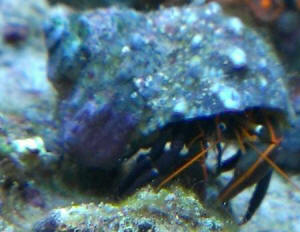 |
|
Please ID This Crab for Me: Large Hermit – 5/22/12
Would you please ID this crab for me?
<I’ll certainly give it a try.>
He is from the Keys. He is in a shell approx. 4" long
<It appears to be from a Tulip snail (Fasciolaria spp.)>
...and his legs are at least 2.5/3" long
<Yikes, that’s a sizeable hermit!>
-- deep orange w/black erratic stripes on legs.
<Pretty>
When I Google “red hermit crabs” no images show up with black stripes on
legs.
<I’m having trouble as well. I’ve looked through my research
books, and on the web, but cannot find a match. In order to narrow
the field a bit, I’d need more information starting with the claws.
If they’re still present (or if you can recall), are/were they the same
size or noticeably unequal? If unequal, which was larger, the
right or left?>
Also, can he live in my reef tank (underwater) with no rock above water
to climb out onto?
<I’d need to know which species it is before I could answer with any
certainty. It would help to know where the animal was collected.
If you picked it up, was it above-water on dry sand, on the beach or
maybe a jetty in the tidal/surf zone, or below it entirely? If it
was below, how far out from the beach? If, however, you bought the
hermit at a pet store, was it kept underwater or in a
beach/terrarium-type system?
What’s important to note is that keeping large hermits in reef systems
can be problematic. First of all, these are opportunistic
omnivores and scavengers with big appetites. If they get hungry
enough, they will go after whatever they can grab and eat, including
fishes and other invertebrates. Beyond that, they’re not exactly
dainty when it comes to moving about. They have an unfortunate
tendency to knock things loose and rearrange aquascapes. The
bottom line is that even if this is a full-on reef hermit, it’s a risk.
Larger hermits are better suited to either species-specific or large
fish-only systems stocked with active/aware fishes. For more
information and photos, please see Bob’s hermit section:
http://www.wetwebmedia.com/marine/inverts/arthropoda/crabs/hermitcrabs.htm
>
Thank you for your help.
<You’re very welcome. Take care, Lynn Z>
|
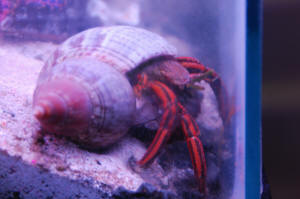 A beauty!
A beauty!
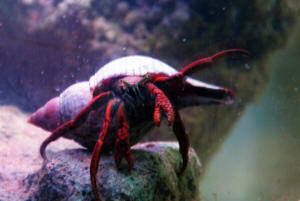
Re: Please ID This Crab for Me: Large Hermit - 5/26/12
<Hello Beverly!>
Lynn, thank you for your interest in trying to solve the 'mystery crab'
issue for us.
<No problem, I just wish I could have given you a concrete ID.>
The crab is alive and has been in my son's reef tank for only 2 wks.
<Okay>
He was obtained in the Fl. Keys.....between Key West and Marathon......from
the ocean......about 4-5 ft. from the rocky shoreline, underwater. It
has such pretty markings
<It does indeed.>
- the lines on its legs, etc. Two front legs are at least 2.5"
long...maybe 3". If any of this info can help or this new photo I've
sent.
<I wish it were so but unfortunately, despite additional research, I cannot
identify it.>
I want to make sure it can live completely underwater
<I think it’ll be fine.>
(my son has not fixed anything for it to crawl out onto) and the only thing
in his tank is a large piece of live rock, for now. It is only a 20
gallon long, tank so he's thinking he can only have 2 fish and wondering if
the crab will eat them.
<If it gets hungry enough it may at least try.>
He's feeding it frozen miso <Mysis?> shrimp presently which it readily eats.
<You could also offer it bits of table shrimp, fish, clam, or squid.>
It managed to crawl up and out of the tank a few days ago, using the long
pipe from the water filter and fell onto the floor.
<Yowza, that’s a good way to end up as a dog or cat toy/treat!>
Luckily we found it and it recovered once back in the tank.
<It could well be an intertidal species, accustomed to being in and out of
the water.>
We need to figure out some type of cover (screen? or something)
<Definitely!>
He has LED lights on the tank that change colors.
<Sounds pretty>
Thank you for any help you can offer.
<You’re very welcome; again, I’m just sorry that I couldn’t help with the
ID!>
I 'Googled' 'hermit crabs' and so many images came up but none looked like
this one.
<Yep, I had the same issue, with search engines and various books.>
~Beverly~
<Take care, Lynn Z>
Follow-up Re: Re: Please ID This Crab for Me: Large
Hermit - 5/26/12
Error: I mean Mysis shrimp.
<No Worries!>
Thanks, Chris
<You’re very welcome. Lynn Z>
Follow-up Re: Re: Please ID This Crab for Me: Large Hermit -
5/26/12
Error: I mean Mysis shrimp.
<No Worries!>
Thanks, Chris
<You’re very welcome. Lynn Z>
|
|
Identify This Hermit Crab: Calcinus laevimanus --
6/27/10
Hi Crew....
<Hi Gretchen, Lynn here today.>
I couldn't find anyone who could identify this hermit crab
that I've had for over a year now. He's never come after
any of the fish (I doubt he could catch them anyway),
<The fish would most likely have to be dead, injured,
sleeping, or otherwise caught unawares.>
..but I wouldn't be surprised if he's made a meal out of
a Turbo or 2 to get at their shell.
<It happens. Be sure to keep the hermit well fed with meaty
bits of shrimp, fish, clam, pellet food, etc., as well as dried
seaweed/Nori in hopes that it will deter future
predation.>
I have no issues with him, but I'd just like to know what
type of crab he is. He's got one huge claw, and hairless
orange legs (plus a white stripe at the bottom of the
leg)....Here are pictures of it:
http://i722.photobucket.com/albums/ww227/wontonflip/125gallon/smDSC1697.jpg
http://i722.photobucket.com/albums/ww227/wontonflip/125gallon/_DSC2593_500x318.jpg
<Thanks for the photos! Your pretty little hermit looks like
Calcinus laevimanus, commonly referred to as a left-handed or
zebra hermit. Please see the following links for comparison:
http://www.flmnh.ufl.edu/reefs/guamimg/crustacea/anomura/Pages/Image10.html
http://www.meerwasser-lexikon.de/images/rBturAvW8q.jpg
>
Thanks!
<You're welcome, enjoy!>
Gretchen
<Take care, Lynn Z>
Re: Identify This Hermit Crab: Calcinus laevimanus --
6/27/10
<Hi Gretchen>
YES! That's him! Thanks for the response, Lynn! :D
<You're very welcome!>
Gretchen
<Take care, Lynn Z>
|
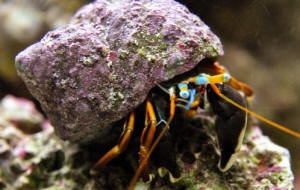 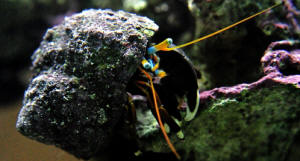 |
|
Hermit ID 5/30/2010
Hello WWM,
<Hot>
I have been trying to identify the crab in the attachments. I
bought it thinking it was a bumblebee snail. When I saw it moving
as fast as it was I flipped it over..and waited...and
waited...then finally the legs appeared.
I couldn't find any thing on your site or the internet for
this crab and wrote it off as a crab hi-jacking a bumblebee snail
shell.
<This image is too small and poorly resolved to be of use.
Please review here:
http://wetwebmedia.com/marine/inverts/arthropoda/crabs/hermitcrabs.htm
and the linked Hermit ID FAQs files above... Commonly encountered
and utilized Anomuran species are found here. Bob Fenner>
The more I think about it the more I wonder what are the odds of
a crab with yellow and black stripped legs just happening upon a
yellow and black stripped snail shell to hijack.
What is this crab?
Regards,
Barb
|
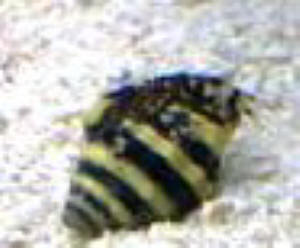 |
|
Re: Hermit ID 6/1/10
Hello Bob,
Thank you for your reply. It amazes me how quickly this site
answers questions.
I attached two photos to the previous email. I will attach the
second one again.
<... junk>
My thought was also that it was a hermit crab, but again, I
cannot find one that looks like it. Well, I am amused by it. I
suppose that's all that really matters.
<No...>
Thanks again.
Barb
<Read where you were previously referred. B>
|
|
Hermit Crab Identification 1/11/10
Dear WWM crew, <Hi Rafy> Great site, I must say. It has
been my ultimate reference in marine aquarium hobby for the past
1 year. <Mine too> Keep up the good job! By the way, I
would like to seek your expert opinion to identify the type of
Hermit Crab I have over here. <nice photo's>They have
orange legs with black stripes, and orange eyes with yellow tip.
There is some white patch on the back of its head, somewhere near
the thorax <yes,
distinctive>. My questions are as follow :
1) The LFS claimed that this is Red Legged Hermit Crab but after
research, I suspect this is actually Halloween Hermit Crab
(mainly based on the black-orange striped legs). What is your
opinion on this? <I agree with you this looks like
Ciliopagurus strigatus (Halloween Hermit) to me. See here:
http://www.recif.be/article/hermit.htm>
2) After some research, I found some clashing claims. Some
website claimed that this hermit crab can be rather large (are
they confused with Halloween Crab?) but some claim that this
species is reef safe and can only grow up to 2"
<Yes, but 2" is large for a crab in a reef tank, and no
crab save commensal coral crabs are reef safe IMO. They are all
opportunistic omnivorous scavengers. That means they'll eat
anything> 3) Some site listed that the other name for this
type of hermit crab is Cone Shell Hermit Crab. Does it mean that
I must prepare spare conical shells for them? <No, but if you
want him to grow to 2" you will need to provide a new
'home' for him at
some time if he is only small now> Thank you very much for
your time :) <No problem!> RAFY <Simon>
|
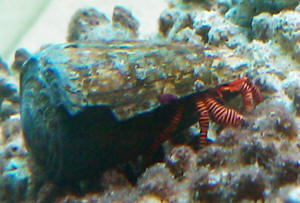 |
|
Who's that crab? Anomuran IDs... for what?
9/30/09
You guys are always helpful, and awesome!
So, I figured I'd give it a try to see if you could help me
figure out what kind of LARGE crab this is. We got him about four
years ago from PetCo. Of course, labeled "hermit crab -
Saltwater" and after asking them about him, they were as
helpful as expected....which is to say not at all and called him
a general hermit crab that sometimes but rarely came in
shipment.
<... then... why did you buy it?>
Anyway, the aptly named "Blue Crab" lived happily for a
while but due to some unfortunate accident, he died. We've
been looking for another one ever since! He was about 2.5-3
inches in size. Blue, with white eye stalks with yellow tips, and
black eyeballs. Yellow antennae, and white fuzz on his blue legs
and claws. (See photo if I attached properly.)
<... Looks to be a Dardanus lagopodes... 'cept for the
body colour. This species is usually maroon/reddish...>
As a bonus, we also used to have a very LARGE hermit crab (Gomez)
who was dark pinto green, with thin red/brown accents. Smooth,
not fuzzy, with thick, but not giant claws. This guy got
about3.5-4 inches before he died. We don't know what kind of
hermit he was either! We've asked fish dealers and hobbyists,
and pet stores and no one seems to know anything much about large
hermits, except for the most popular kind.
Please help...and thank you! : )
Melissa & Kevin
<... will ask LynnZ if she can run down for you. Bob
Fenner>
|
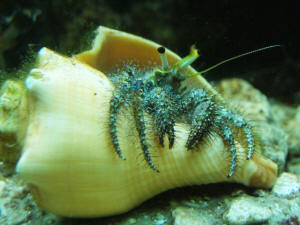 
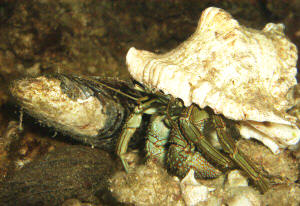 |
|
Re: Who's that crab? Anomuran IDs... for what?
9/30/09
<Hello, Melissa and Kevin - Lynn here this afternoon.>
You guys are always helpful, and awesome!
<On behalf of Bob and crew, I thank you!>
So, I figured I'd give it a try to see if you could help me
figure out what kind of LARGE crab this is. We got him about four
years ago from PetCo. Of course, labeled "hermit crab -
Saltwater"
<Yep, that sort of generality is cause to run to your trusty
research book or internet site(s) before buying, to make sure the
animal will be a good/safe addition for your system.>
..and after asking them about him, they were as helpful as
expected....which is to say not at all and called him a general
hermit crab that sometimes but rarely came in shipment.
<I'd love to know where those shipments were from!>
Anyway, the aptly named "Blue Crab" lived happily for a
while but due to some unfortunate accident, he died. We've
been looking for another one ever since!
<I'd keep checking Petco, in hopes that they're still
getting shipments from the same area. Perhaps another such hermit
will show up.>
He was about 2.5-3 inches in size. Blue, with white eye stalks
with yellow tips, and black eyeballs. Yellow antennae, and white
fuzz on his blue legs and claws. (See photo if I attached
properly.)
<Very pretty! I've looked all over, but the closest I can
get to an ID is what Bob already mentioned, Dardanus lagopodes.
Usually, these hermits are a mottled maroon/red/brown and white,
but I've read reports of color variants. Perhaps this is one.
If you wish to look further I'd recommend trying a few
internet image search engines (Google, Bing, etc.) using the
genus name: Dardanus.>
As a bonus, we also used to have a very LARGE hermit crab (Gomez)
who was dark pinto green, with thin red/brown accents. Smooth,
not fuzzy, with thick, but not giant claws. This guy got about
3.5-4 inches before he died. We don't know what kind of
hermit he was either!
<I'm sorry to say that I don't either. I can't
quite see enough detail to be of much assistance. For instance,
are the claws of equal in size, or different? Hermits in the
family Diogenidae tend to have a larger left claw relative to the
right, while those in Paguridae tend to have a larger right claw
than left. If you remember, or have other photos that show this,
perhaps you could search according to family, then narrow things
from there.>
We've asked fish dealers and hobbyists, and pet stores and no
one seems to know anything much about large hermits, except for
the most popular kind.
<Well, there are a lot of them out there!>
Please help...and thank you! : )
<You're very welcome, and good luck in your
search!>
Melissa & Kevin
<Take care, LynnZ>
Re: Who's that crab? Anomuran IDs... for what?
9/30/09
<Hello again!>
Thank you so much!
<You're very welcome!
The green crab had claws that were the same size, as did the blue
crab!
<Gotcha>
Maybe if they had gotten bigger or older it would have varied
where one was bigger?
<Well, the difference in claw sizes related to family is
something that can help with an ID but it's not a guarantee.
That's why I was careful to use the phrase 'tend to'
instead of 'always'. The differences could be slight or
not at all and on top of that, there could be other factors at
play.>
Probably not, but they were super crabs. We really miss them!
<I can certainly understand that!>
Thanks again for the help.
<It was a pleasure.>
We'll keep searching!!
<Please do! If/when you do find another, please send more
photos and we'll see if we can't figure out what
you've got. Take care, LynnZ>
Follow-up: Re: Re: Who's that crab? Anomuran
IDs... for what? 10/1/09
<Hi Melissa!>
With your and Bob's help for a start on the Latin name, we
found this French site:
http://users.skynet.be/fa311324/article/hermit.htm
<Ah yes, you found one of my favorites. It's loaded with
wonderful photos. Here's another site as well:
http://www.deepseaimages.com/dsilibrary/showgallery.php?cat=675
See families Diogenidae and Paguridae, starting about halfway
down the page:
http://www.roboastra.com/hastherm/hpherm.html>
..(Also, at the bottom there is "Phimochirus holthuisi"
which says Photo credit Bob Fenner. Thought that was cute! :
)
<Yes indeed, another wonderful photo!>
But about halfway down it shows "Dardanus lagopodes"
which is a tiny bit more red but has the exact same eye stalks
and yellow antennae as our long lost blue crab.
<I know the photo and yes, it is indeed very similar. Here are
several others as well:
http://www.deepseaimages.com/dsilibrary/showphoto.php?photo=7001&cat=675
http://cookislands.bishopmuseum.org/species.asp?id=7270 >
So, I'd guess we would have to agree with you guys on what he
was!
<It does indeed appear to be either a color variant or another
species in that genus.>
He was such a vibrant blue though...I wish we could have kept him
alive!
<Indeed. I found an interesting parallel on the 'net last
night after my last response. It deals with what appears to be a
blue specimen of Pagurus bernhardus found off the coast of
England. See this link: http://www.glaucus.org.uk/Torped56.html.
It's postulated that the color might be due to a parasite. I
honestly don't know if that's possible or not. Have you
ever seen a blue lobster? The beautiful color is apparently due
to a genetic defect that can be described at the following link.
It may be more than you ever wanted to know on the subject, but
it's interesting!
http://srs.dl.ac.uk/Annual_Reports/AnRep01_02/pdf/08_09%20Crustacyanin.pdf >
We were soooo new to the hobby back then, and for some reason got
something in our tank that killed all of our crustaceans, even
the copepods.
<Aggressive hermits can do a number on their crustacean
relatives, snails, and even fishes if they can grab, or catch
them sleeping. As for the copepods, they may well have been
reduced by various fishes you had at the time.>
Fish were fine..who knows!
<They may well have either steered clear of the hermits or
slept out of reach of them!>
It's just been trial and error after trial and error for
us!
<Yep, in this hobby you find out pretty quickly that research
is your friend! That is, research *before* bringing home!>
Everything is healthy and thriving now and has been for a few
years.
<Good to hear. I'm wondering if there isn't a parallel
between this and the lack of large hermits!>
Anyway, I think it might be the same species. Obviously there are
more sites out there that show a crab that looks like him, like
this: http://www.zipcodezoo.com/hp350/Dardanus_lagopodes_0.jpg
But I've still yet to find one that's blue!
<Same here!>
Anyway, the PetCo in our area stopped carrying saltwater
animals...and I actually think that's really good because
they were always so sad, dying, or badly taken care of.
<That's frustratingly sad to see. I've seen both ends
of the spectrum in our area. It just depends on who's in
charge/running the section.>
Still not sure on the green crab. He grew pretty fast and so I
expect he would have gotten larger. That French site has two
photos of crabs labeled "Clibanarius sp"...which I
assume means "Clibanarius species of some sort"
*lol*
<That's exactly what it means!>
He was really olive green but the markings on these crabs look
similar, and his claws were about the same size as these look to
be (of course like you said they are probably slightly different,
but at a glance they look about the same size). Okay, anyway,
thank you again so much!
<You're very welcome! It's been a learning experience
for me as well and I appreciate it!>
I've been meaning to ask for years and just never got around
to it.
<I'm glad you got around to it. If I ever run into a blue
hermit like yours, I'll be sure to let you know.>
You've been really sweet and helpful...Have a great week!! :
)
<It was my pleasure. You have a great week as well!>
Melissa
<Take care, LynnZ>
|
|
White Leg Hermit? 3/16/2009
Please help me ID this little guy! I was at the local pet store
when I noticed they were getting a new shipment in of hermits.
They placed them all in their tank and I took my pick. There was
a little white legged hermit... with blue on the stalks of his
eyes.. I had to have him! He is different from all the rest of
the hermits I have. His claws in the front are very small.
It seems like he has no antennas like the others do. I have a
dwarf zebra crab, 3 blue legs and 2 scarlet red legs. I brought
him home, and put him into my tank. I was unsure about what kind
he is, and figured I would
just "look him up". No luck!! I just want to make sure
that he is reef safe,
<This... is a matter of degree... some Anomurans are
"pretty" reef safe... others far to the other side of
the spectrum... This one is very likely on the "pretty
safe" side... and stays small if it's what I think it
is>
and actually know what he is!
<Might be a Calcinus latens...>
The other tank inhabitants are a sea apple, <Yikes! Do see WWM
re... these Cucumbers are notorious for tank wipe-outs>
2 percula clown fish, a serpent star fish, a chocolate chip star
and an engineer goby. Thanks for your help!!
Danielle
Attached is some photos to help!
<Be reading, chatting, Bob Fenner>
|
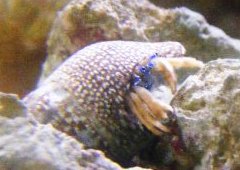 |
|
Hermit Crab Care 1/8/09 Hi.
<Hi Misty> I found your webpage after making my best
attempt to identify the crab I have as well as learn the best way
to care for it. My husband and I recently spent some time in
Panama City, FL, where we were collecting shells and whatnot.
Yes, I have come to realize, you read hundreds of emails just
like this! We discovered this little guy in the bay. I am still
unsure what kind of hermit crab he is but I am thinking C.
vittatus. Could you please correct me if I am wrong. <Try
to.> I know basically nothing about caring for marine animals.
But, alas have decided to give it a go. I have found your website
extremely helpful. After spending a week in a plastic Tupperware
dish, in some sea water scooped from the bay, today he went into
a tank. We went to our local salt water aquarium store and
purchased a 10 gallon tank, some Instant Ocean, a filter, a
hydrometer, 2 lbs of live rock, de-chlorinator, and
"live" sand. After all the preparation steps of getting
the water ready and settled, in he went, along with many of the
shells found from his very beach. I did boil the shells before
placing them in the water. I also purchased frozen baby brine
shrimp which has to be dissolved in water for him to eat.
<Baby brine is a little small for a food source, I'd go
with small pieces of fish.> So, in the hour or so that he has
been in this new environment he has explored and thoroughly
examined each and every shell I put in there. And, changed shells
now 3 times! I am under the assumption he is happy because he
scoping everything out and seems to be doing quite well. I
discovered tonight while watching him closely as he was shell
hopping that he is missing a whole leg and one of his claws, both
of which are on the same side of his body. This leaves him with
only one usable leg on that side. Really what I am concerned
about is if he will continue to thrive being "disabled"
as he is. I have no idea if this leg loss has occurred since we
brought him home or if he was this way when we kidnapped him.
<Not unusual to see this. When the crab molts, he should have
a new claw and legs. As crabs grow, they will molt on a regular
basis. So, as long as you keep the little guy fed, I see no
problems.> My last concern is the salinity and temperature in
which he should be kept, being that he came from the gulf. Any
information you can provide to me will be greatly appreciated.
<Hermit crabs are very hardy creatures and are very tolerant
of water conditions. A salinity of 1.020-1.023 will be fine. For
temperature, set about 75.> Thank you so much for your time.
<You're welcome, and get that guy some fish and learn more
about your find here.
http://www.wetwebmedia.com/marine/inverts/arthropoda/crabs/hermitcrabs.htm
James (Salty Dog)> Misty Rettagliata ps: I am including 2
photos of him, in hopes that you can help me identify him.
Hopefully they come thru! <I don't see them.>
<<... Is Clibanarius vittatus... and care information can
be found linked at the top of James' citation on WWM:
http://wetwebmedia.com/marine/inverts/arthropoda/crabs/hermitcrabs.htm
BobF>>
Re: Hermit Crab Care 1/9/09
James, Thanks for your response. <You're welcome.> I am
slightly frustrated the pictures didn't come thru. I am going
to attempt to send them as attachments this time. Today has gone
well. The little bugger has been shell hopping like crazy. Its
almost like a game between the same 3 shells.....back and forth
and over again! You had very little to remark about everything I
said (except probably the absolute essentials) so am I to assume
that thus far I am proceeding correctly? <Yes, but I've
also posted a link leading you to much more info than I have the
time to provide here.> I went back to the fish store today and
talked the guy's ear off trying to get as much information as
I could. When I asked for some fish to feed crabby he basically
put me off saying that it would be better to not put something
like that into the tank and instead gave me shrimp pellets.
<That will work. Hermit Crabs are scavengers by nature and
will eat most anything.> I didn't want to argue because I
know everyone does things differently. I figure I can pick up
some fish at the grocery store! <The fish was meant as an
example of foods they will eat. As long as you have already
bought the shrimp pellets, you might as well use them.> While
I was there I also bought a heater and thermometer, because I was
worried the water temp was too chilly based on what you
recommended. I was correct. The water temp was around 66 degrees
F. As of now it's a comfy 74. <Is fine.> I am going
cuckoo, however, after reading things about the nitrates, iodine,
ammonia, and a million other things it seems as if I should be
monitoring, yet not knowing how! <As I mentioned before,
hermit crabs are very tolerant of water conditions and as for
water testing, I wouldn't worry too much here as long as the
crab will be the only animal in the tank. Watch your feeding
habits, a small portion a day is all that is necessary and a
monthly one gallon water change will be beneficial.> Is there
anything you can suggest I do differently from what I told you
previously? <Not for keeping a hermit crab, you have the basic
equipment, but I do suggest you clean/change the filter media at
least twice monthly.> And, I am interested in adding a 2,
maybe 3 damsels and perhaps one more small hermit. Is this
something you think would be wise? <It can work but two small
damsels would be the limit for a 10 gallon tank. Do not consider
those cute little black ones with the three white spots (Three
Spot Damsel) as they will soon overgrow your ten gallon tank. The
Yellowtail Damselfish is small, colorful and an easy to keep
fish. Further reading on damselfish can be found here.
http://www.wetwebmedia.com/damsels.htm> Is there much more
that would need to be done before taking those steps? <Yes,
now we are on a different page, we are going to need some type of
biological filtration as a first step. Do read here and related
articles/FAQ's, this will give you a good overview of the
basics. http://www.wetwebmedia.com/marineSetUp.htm I've also
provided an index to additional information available.
http://www.wetwebmedia.com/marine/setup/marsetupindex1.htm>
Again, I appreciate all the knowledge you guys are able to share.
And I am enjoying this website greatly. I have been reading tons.
<Reading will be your best teacher, enjoy.> Thanks so much!
Misty
|
 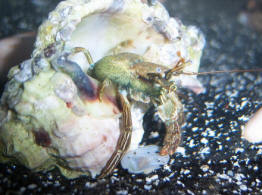 |
|
Hermit Crab ID 1/10/09 Misty, I am going to
answer the hermit crab ID separate from hermit crab care for ease
of filing in our system. Your suggestion of C. vittatus is
actually a scorpion, not a hermit crab. I'm thinking your
crab is a Clibanarius. James (Salty Dog)> <<What,
scorpion? RMF>>
Re: Hermit Crab ID 01/09/09 Bob, Probably my
fault on the ID as I didn't think two creatures would be
identified as vittatus. Should have investigated the
"C." further. Look here.
http://www.ub.ntnu.no/scorpion-files/c_vittatus.php James
<Mmm, perhaps a note here... the second part of scientific
names can/do get used over and over... Genera (plural for genus,
the first part of a species name) are supposed to be unique.
BobF>
Re: Hermit Crab ID 1/10/09 I am sorry for the
confusion. I guess that shows how little I know and how much I
need to study because I was meaning Clibanarius vittatus, simply
shortened it to C. Vittatus not knowing that it too was already a
creature (scorpion)! That being said, then I was correct in my
home id of him. <Actually I erred thinking the "C"
was Clibanarius. Your crab is a Clibanarius vittatus.> I
can't say it enough, thank you thank you thank you and
everyone else for your time and help in these situations.
<You're welcome. James (Salty Dog)> Misty
|
|
|

